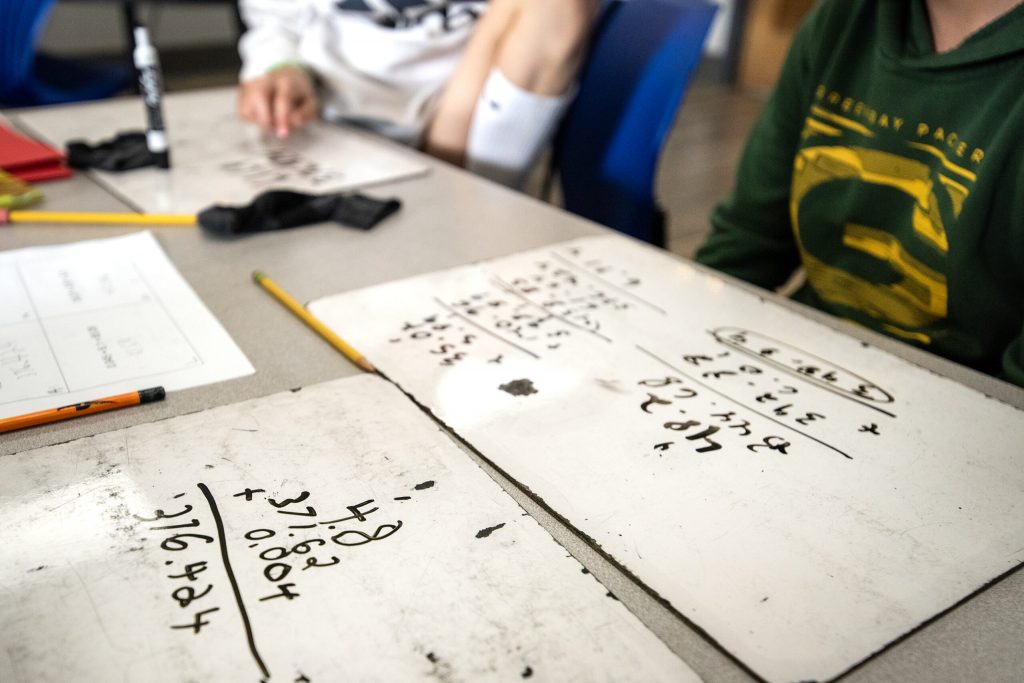Wisconsin’s 4th and 8th Graders Rank Above Average in Math
But state has room for improvement in basic math literacy.

Fifth-graders work during a math lesson Tuesday, April 29, 2025, at Winskill Elementary School in Lancaster, Wis. Angela Major/WPR
How Wisconsin’s K-12 students are learning math is changing.
In the latest National Report Card by the National Center for Education Statistics, Wisconsin students in 2024 ranked above the national average for math performance in both fourth and eighth grade classes. But disparities between classrooms across the state show nearly a quarter of fourth grade students remain behind on basic math literacy — or “numeracy.”
On WPR’s “Wisconsin Today,” a panel of math educators discussed the state of mathematics education in Wisconsin.
Deb Heitman is a fifth grade teacher and math instruction coach for the Coleman School District. She also represents the third, fourth and fifth grades on the Wisconsin Mathematics Council. Heitman said the key to successfully teaching math to students begins with being open to the idea that students should be thinking about the structures of math beyond “just memorization.”
“Math classrooms nowadays definitely look different from when I was younger, so to be able to see it in action is very different than just hearing about it,” she said. “Because also we need to be able to ask the questions, to get the students thinking, which is something I had to learn through the years, and it didn’t come naturally at first.”
A report by the National Council on Teacher Quality found that only 1 in 8 colleges are adequately teaching their education students on modern math practices.
Northern Ozaukee School District high school math teacher Steve Akin said mentor programs that pair new teachers with more experienced ones could go a long way in boosting both teacher confidence and ability.
“[The first years of teaching] are clearly the hardest years, and there are things you just can’t teach,” he said. “So if a student [is] having a bad day, and the teacher can’t diagnose that and doesn’t know how to respond, it’d be nice if there was an experienced teacher nearby who could say ‘Hey, come here. Let me just point out what I see.’ … I just think that that would have really helped me and some of my colleagues at the high school level.”
Akin also sits on the Wisconsin Mathematics Council as co-chair.
Akin touted that organization’s CNECT program, where teachers can collaborate and ask questions among peers to improve their skills.
Wisconsin Department of Public Instruction Education Consultant Mary Mooney told “Wisconsin Today” that policy decisions around math instruction largely fall to local districts rather than the state.
In 2023, Gov. Tony Evers signed Act 20 into law, which established a literacy department and added statewide standards for reading and writing comprehension. There isn’t really a similar program when it comes to Wisconsin’s “numeracy,” Mooney said.
“Mathematics, honestly, is used to being maybe second to literacy,” she said. “We know literacy is very important, but many times that just leaves mathematics in this strange, difficult space where many people don’t really tackle it.”
Mooney said she expects math standards to get more attention in the coming years, but there remains plenty of debate over what they should look like.
Wisconsin’s fourth and eighth grade students are above average in math was originally published by Wisconsin Public Radio.
If you think stories like this are important, become a member of Urban Milwaukee and help support real, independent journalism. Plus you get some cool added benefits.




















